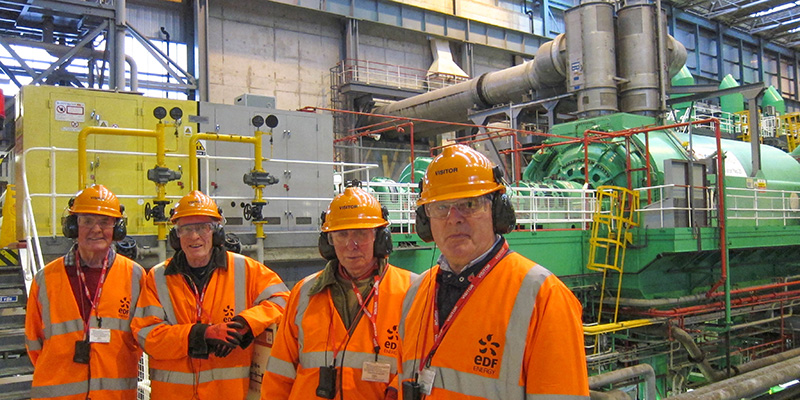Coincident with the EDF announcement that Dungeness B nuclear power station will stay open for 10 years beyond its scheduled closing date of 2018, members of the Rye Emergency Action Community Team (React) – Mike Slavin, Granville Bantick, John Holbrook and myself – visited the station. This was part of an ongoing programme to consider risks which might impact on Rye.
After safety briefings, we toured the main parts of the installation, guided by EDF’s Sarah Mayberry and saw work underway to dismantle the neighbouring Dungeness A station, which was decommissioned in 2006. At the end, we had an informative meeting with station director Martin Pearson.
The building of Dungeness B as a prototype station began in 1965, with electricity generated in 1983. It now employs 550 people and six apprentices, plus 200 contract staff. The station had been scheduled to close in 2008, but its then operator, British Energy, extended its life by 10 years to 2018. The nuclear authorities have now agreed that EDF can extend its life to 2028. It generates enough power for around 1.5 million homes.
React was interested in the engineering assessments which lay behind this extension. We were told that the two advanced gas-cooled reactors at Dungeness B incorporate thousands of graphite bricks at its core. The graphite acts as a moderator to slow the neutrons sustaining the nuclear reaction. Over time the graphite cracks and suffers loss of mass, all of which is well known and anticipated within set safe margins.
From a continuous programme of inspection and physical sampling the state of the graphite is carefully monitored. Extensive modelling has provided the data to allow EDF to increase safely the graphite degradation limits from 6.2 per cent to 8 per cent, allowing longer service time.
Pearson explained that his number one priority was safety. “Life extension, which has been approved by the Office of Nuclear Regulation, means the station will continue to provide hundreds of skilled jobs and provide . . . more than £40million to the local economy.”
Ministers say that the life extension at Dungeness will bridge the power generation gap until after 2023 when the new EDF station will come on stream at Hinkley Point in Somerset.
Pearson explained that lessons had been learnt from the 2011 Fukushima nuclear disaster in Japan. Although a tsunami type risk was low, there could be sea flood risk aggravated by tidal surge. To mitigate this there has been investment in additional rock protection on the foreshore, a 1.5m perimeter flood defence wall, additional resilience measures for its control systems and contingency support for its vital sea-water cooling plant.
Although built on shingle, the station is securely tethered to deep concrete foundations which meet rules designed to handle seismic movement. To counter the terrorist threat, there are significant physical security measures in place. This was a valuable visit, enabling React members to see the engineering, the considerable safety systems and to hear for themselves about the risks of running a nuclear plant at Dungeness.
Anthony Kimber is chairman of React



